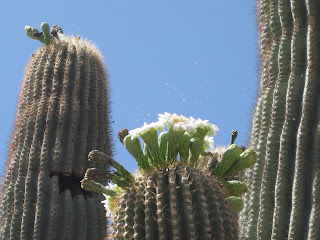Petrified Forest
First stop was the Petrified Forest National Park, where large amounts of petrified tree trunks sit in the middle of the desert. The trees lived on a large floodplain in the Late Triassic, over 225 million years ago and were then buried by mud and volcanic ash. Silica rich groundwater has infiltrated the wood and crystallised in the wood tissues, preserving the wood. Along with all the wood there have been many dinosaur fossils found in the area. The sediment is rapidly eroding around the trees, exposing more and also causing the fossil wood to roll into hollows under gravity. |
| Petrified log |
 |
| Bits of logs that have eroded out of the hills |
 |
| Painted Desert |
This area was once occupied by humans as far back as 10,000 years ago. There is evidence of dwellings and pueblos (villages) built out of rocks and petroglyphs carved in to the desert varnish on some of the large boulders and cliffs. It seems amazing that people could live in this rather hostile environment. They were probably concentrated around the rivers and washes which run at some times during the year.
Petroglyphs carved in to the desert varnish
Canyon de Chelly
Then we headed north to Canyon de Chelly (pronounced d'shay) National Monument on the Navajo Indian Reservation. This is a spectacular canyon system - Canyon de Chelly in the south and Canyon del Muerto (death - doesn't bode well). Where the canyons meet they are only 10 m deep, but they are up to 300 m deep further upstream. The exposed cliff walls are made up of ancient sand dunes, stained red by iron.
Sandstone cliffs made up of sand dunes with steeply angled beds
The main story, however, is about the archaeology of the area with the earliest inhabitants around 2500 BC with evidence for organised pueblos in 750 AD. The pueblos were built in caves in the cliff, for protection. I'm not entirely sure how they got up to the caves in some circumstances as it looks pretty vertical. I guess that was the point - to protect themselves.
Aaron, Judy and Helen walked down to the bottom of the canyon to check out the White House ruins, where the canyon quiet was challenged by a large number of Navajo primary school students on an excursion during free entry to National Parks and Monuments week.
 |
| White House Ruins |
 |
| Mummy Cave |
 |
| Spider Rocks |
Around 1600 AD the Hopi Indians appear to have left the canyons, the reason is not clear - possibly due to drought, disease, conflict or news of better lands elsewhere. The Navajo Indians arrived in 1700 AD and farmed the land at the bottom of the canyons - just as they do today. They grow corn, peaches and raise sheep and goats. It was very dry when we were there, with only a small stream flowing down the canyons and little grass, but we met a local who told us that they wait until the monsoon season before they start farming.
The US millitary destroyed the crops, Hogans (houses) and livestock and removed the remaining Navajo from the canyon in 1863, after 17 years of ongoing conflict. The Navajo were allowed to return in 1868 to rebuild their lives.
South Mountain
Back in Phoenix it was hot so we spent a lot of the main part of the day inside in shopping malls or visiting people, we had to get up early to do anything outside, other than splash in the swimming pool. We got up early-ish on two mornings and went for a walk on South Mountain, one of Aaron's old mountain biking haunts. Unfortunately we missed the main wildflower season, but the cacti were just starting to flower.
 |
| Prickly Pear Cactus blossom |
Saguaro Cactus blossoms
 |
| Aaron walking on the National Trail past a large Saguaro Cactus |
 |
| Tunnel to Hidden Valley |
 |
| Just squeezing through Fat Man's Pass |
Sedona
Aaron's brother Craig, brought his our nieces and nephew down to Phoenix for the last few days. We also spent an evening with Judy's brothers (and partner). Due to a large number of the Lyman clan in one place (first time since our wedding) Kendall had organised for family photos. We look forward to seeing how they turned out....
We also had a family outing to Sedona, so that Uncle Les could take us out in his jeep on some of the 4WD tracks around the area. While others were out on the jeep, Aaron and I also went for a short climb up Bell Rock.
Les Lyman's jeep tours
 |
| Bell Rock |
 |
| Halfway up Bell Rock |
 |
| Sedona red rocks |
With climbing temperatures.... we were looking forward to escaping Phoenix....



